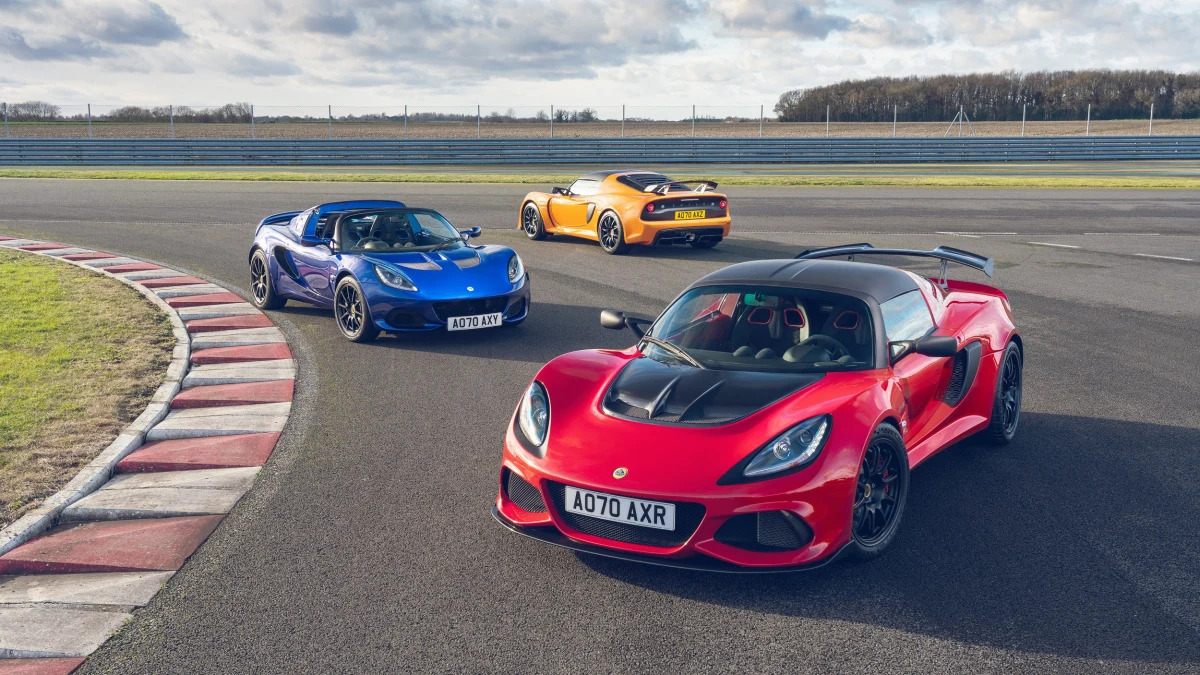Lotus will put the Elise, the Exige, and the Evora out to pasture later in 2021 to make room for a new model that internally is being called Type 131. Before it embarks on this major lineup overhaul, the firm will send off the Elise and the Exige — two of its best-known and longest-running models — with a limited Final Edition.
Fittingly, the Final Edition models represent the ultimate evolution of the Elise and the Exige, nameplates released 25 and 21 years ago, respectively. Lotus added power and, somewhat surprisingly, equipment without straying from the famous "light is right" philosophy that shaped both cars. Collectors have two variants of the Elise (Sport 240 and Cup 250) and three of the Exige (Sport 390, Sport 420, and Cup 430) to choose from.
Stepping inside either Final Edition version of the Elise reveals a thin-film transistor (TFT) instrument cluster that can be configured with regular gauges or a racecar-like display, depending on whether motorists plan to hit the road or the track. Lotus also redesigned the steering wheel to give taller drivers more space. New upholstery and stitching patterns round out the major updates, and every Final Edition wears a specific metal plaque.
Outside, the changes include new additions to the palette, including Azure Blue, which was one of the launch colors when the Elise was presented to the press in 1996. Racing Green, the hue worn by the model when it made its global debut at the 1995 edition of the Frankfurt auto show, makes a comeback as well. If 2,032 pounds is too heavy, Lotus offers optional parts (like carbon fiber panels) that shed 53 pounds.
Power for the Elise still comes from a supercharged, 1.8-liter four-cylinder engine mounted directly behind the passenger compartment. It delivers 240 horsepower (23 more than stock) and 180 pound-feet of torque, figures that give the roadster a 4.1-second zero-to-60-mph time. Selecting the Cup model brings a full body kit that generates 145 pounds of downforce at 100 mph and 341 pounds at the Elise's 154-mph top speed.
Like the Elise, the Exige range receives Final Edition-specific paint colors, decals, and other exterior accents. Inside, it's a similar story: Lotus added a TFT screen and a new steering wheel, among other updated parts.
Instead of a four-cylinder, the Exige packs a meaner punch thanks to a supercharged, 3.5-liter V6 tuned to put 397 horsepower (a 47-horse increase) and 310 pound-feet of torque under the driver's right foot. As its name implies, the 420 benefits from a 420-horsepower evolution of the six, while the Cup 430 gets 430.
In its quickest configuration, with the 430-horsepower engine, the Exige takes 3.2 seconds to blast from zero to 60 mph, and it keeps accelerating until it reaches 174 mph. It weighs 2,447 pounds, so it's heavier than the Elise but still shockingly light for a modern car. The list of standard features includes carbon fiber panels, three-way adjustable dampers, adjustable front and rear roll bars, plus 17-inch front wheels and 18-inch rear wheels.
On sale now, the Lotus Elise Final Edition carries a base price of £45,500 in the United Kingdom (around $62,275). Pricing for the Exige starts at £64,000 ($87,600). Neither will be available in America, but production of the Evora is ending in 2021, too, and its sendoff model might be sold on our shores. We'll have a better idea of how Lotus will celebrate the end of the Evora's production run in the coming months.
Lotus will end production of the Elise, the Exige, and the Evora later in 2021. All told, it has sold about 55,000 units of the three cars. While that might not sound impressive, another way to look at it is that the trio represents over half of the production cars that the British company has built since its inception in 1948.










Sign in to post
Please sign in to leave a comment.
Continue